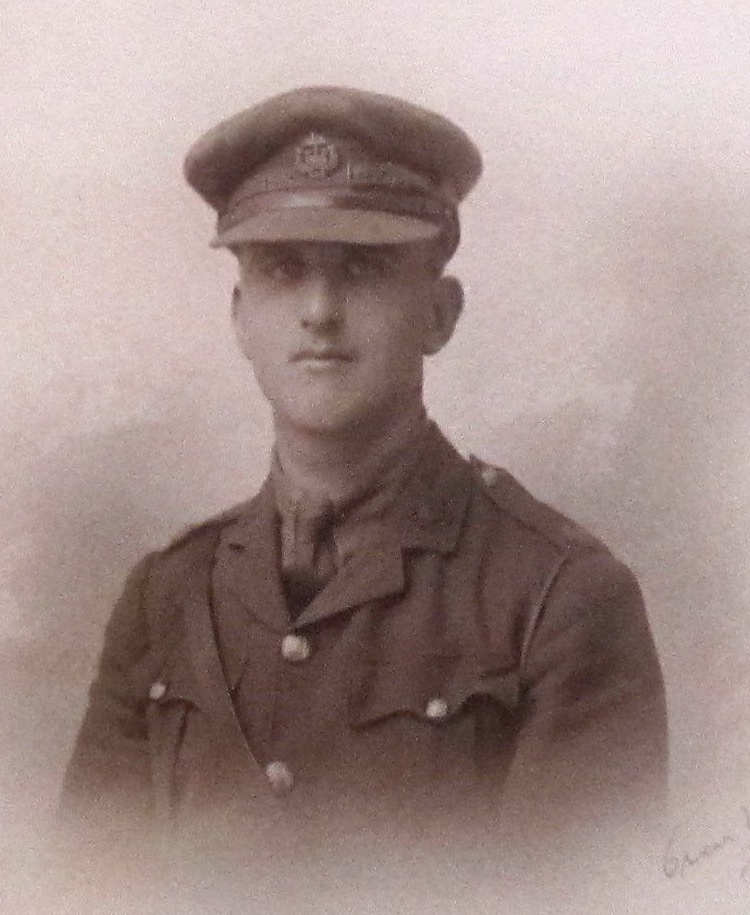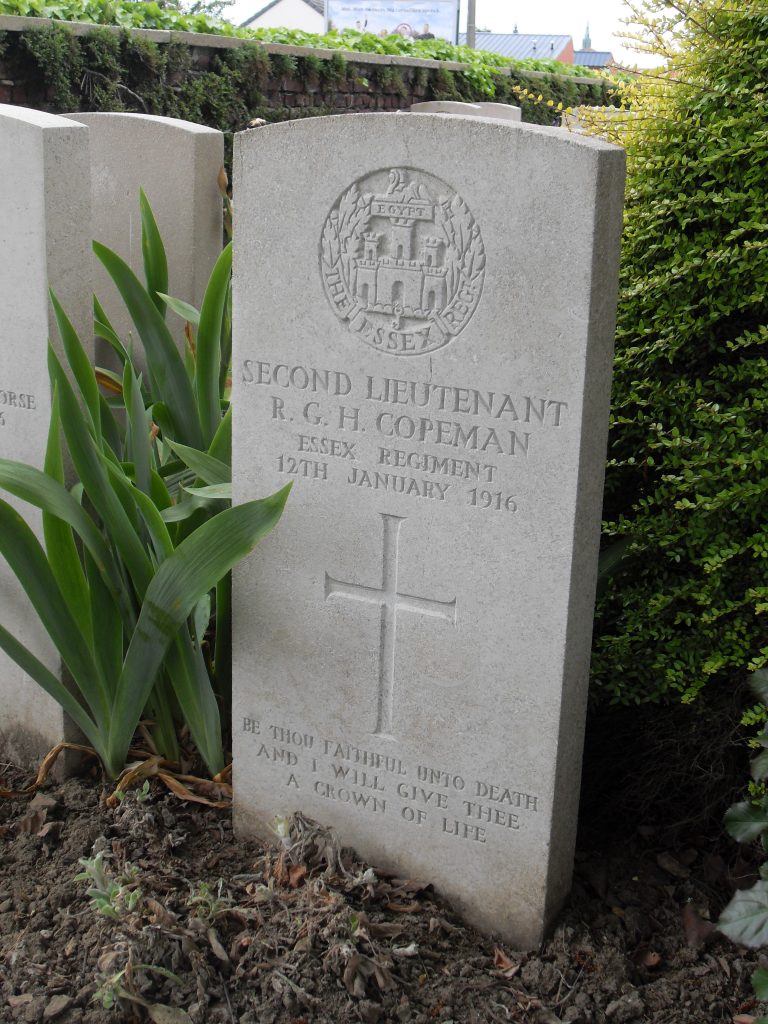Fact file:
Matriculated: 1913
Born: 9 April 1894
Died: 12 January 1916
Regiment: Essex Regiment
Grave/Memorial: Béthune Town Cemetery: II.M.4.
Family background
b. 9 April 1894 in Stoke Albany Rectory, Market Harborough, Leicestershire, as the elder son (three children) of the Reverend Robert Copeman, BA (Cantab) (1858–1939) and Adelaide Mary Anne Copeman (1861–1936) (née Pearson) (m. 1888). At the time of the 1901 Census, the family (plus four servants) was living at 53, Owlstone Road, Cambridge; and at the time of the 1911 Census the family was living at Stoke Albany Rectory, Market Harborough (one servant).
Parents and antecedents
Copeman’s father was the son of George Copeman (1818–83), a barrister of the Inner Temple and a Norfolk landowner, and became a clergyman. He was Curate of Sopley, Hampshire, from 1882 to 1884, Vicar of St George’s, Leicester, from 1885 to 1888, Vicar of Fordingbridge, Hampshire, from 1888 to 1893, Rector of Stoke Albany with Wilbarston, Market Harborough, Northamptonshire, from 1893 to 1918, and Vicar of Everton with Tetworth, Sandy, Bedfordshire, from 1918 to 1921. Copeman’s mother was the daughter of Reverend Henry Pearson (1821–1894), Vicar of Henley, Suffolk.
Siblings and their families
Brother of:
(1) Agatha May (1890–1972);
(2) Charles Neville Christian (later Lieutenant-Colonel, MC) (1896–1966); married (1927) Dora Briseis Coultas (1897–1993), the daughter of a Grantham ironmonger and timber merchant; three children.
Agatha May became a teacher at Queen Anne’s School, Caversham, near Reading, and then a missionary in Africa.
Charles Neville Christian served in the Great War as an officer in the 2nd (Reserve) Battalion of the Leicestershire Regiment and was awarded the MC in the New Year Honours of 1919 for distinguished service in connection with Military Operations in Egypt.
Education
Copeman attended Suffield Park Preparatory School, Cromer, Norfolk (cf. F.R. Charlesworth), from 1904 to 1905 and then, from 1905 to 1913, St John’s School, Leatherhead, where he was a member of the running team and in the Officers’ Training Corps; he also became a School Prefect and was awarded a School Leaving Scholarship. He matriculated at Magdalen as a Mathematical Demy (Scholar) on 14 October 1913, and was exempted from Responsions because he had an Oxford & Cambridge Certificate. Although he passed an additional Responsions paper in September 1913 (Plato), he sat no further examinations after that, and left without taking a degree at the end of Trinity Term 1914 to join the Army on the outbreak of war. During his time at Oxford, he was a member of the Oxford University Hare and Hounds Club and also played cricket and football in Magdalen’s 2nd XIs. President Warren described him posthumously as “capable, loyal and vigorous”.

Robert George Henry Copeman
(Photo courtesy of Magdalen College, Oxford).
“Capable, loyal and vigorous”.
War service
Copeman, who was 6 foot 3 inches tall and a member of the Oxford University Officers’ Training Corps during his year at Magdalen, applied for a commission in the Reserve of Officers on 6 August 1914. Sixteen days later he was commissioned Second Lieutenant in the 5th (Service) Battalion, the Northamptonshire Regiment, his regiment of choice (London Gazette, no. 28,876, 21 August 1914, p. 6,595). But he was then transferred to the 9th (Service) Battalion of the Essex Regiment, which landed at Boulogne on 31 May 1915 as part of the 35th Brigade in the 12th (Eastern) Division. The Battalion first went to the Ploegsteert area, south of Ypres and just north of the French border, to learn about trench warfare, and it stayed there, taking a steady stream of casualties, until 30 September, when it was sent south-east to the Loos area in the aftermath of the first phase of the Battle of Loos (25–28 September).
On 1 October the Battalion took over trenches to the north and the north-north-east of Loos-en-Gohelle that had been captured from the Germans on 27/28 September, at a point that was roughly halfway between Loos-en-Gohelle and the crest of Hill 70, near Benifontaine and the south–north road to La Bassée. Between 26 September and 5 October, when the Battalion withdrew to billets in Vermelles, it had suffered 71 killed, wounded and missing. On 12 October the Battalion was in the trenches near Vermelles in preparation for the disastrous assault on the heavily defended Hohenzollern Redoubt (13 October), which cost the lives of 8,500 British and Indian soldiers and ended the Battle of Loos. On 21 October the Battalion was withdrawn to billets in Béthune, after losing 216 men killed, wounded and missing over the previous nine days. On 26 October, the 12th Division took over the front line from the Guards Division, with the 35th Brigade holding the section from the redoubt at the top of Spurn Head to a point in Savile Row, near Vermelles, facing the Hindenburg Redoubt. Copeman’s Battalion remained in position there until 1 November, with the men suffering considerably from the wet: “the weather conditions […] were about as wet and gloomy as could well be […] The communication trenches became streams of mud.” The Battalion was then in Reserve until 13 November, spent the next five days in billets at Béthune, La Bourse and Vermelles, and returned to the trenches until 24 November, when it was taken by train westwards to rest in billets in the village of Thiennes, about ten miles south-south-west of Hazebrouck. Here it rested and trained, especially in techniques of bombing and sniping, until 10 December when it returned to Béthune for a six-day stint in the trenches east of Givenchy, even though it was between a half and two-thirds of its proper strength because of sickness and casualties.
Copeman, who was part of the Essex Regiment’s Reserve of Officers, had landed in France on 30 October 1915 and joined the Battalion on 30 November 1915, while it was out of the line. From 16 to 21 and 21 to 27 December the Battalion was in Reserve billets at Le Quesnoy and the trenches near Béthune respectively, and it was during this period that Copeman was given command of a Company. Then, on 27 December, the Battalion marched to Festubert, about seven miles east of northern Béthune, and occupied the old British trenches facing the Hohenzollern Redoubt, which were badly damaged, waterlogged because of the heavy rains, and overlooked in daylight by the Germans in Fosse 8: “This part of the British front consisted of a series of islands, standing out in a sea of water and mud, and communication between them was only possible after dark.” The Battalion stayed here until 4 January, rotating half its men in the trenches for 24 hours and half in billets at l’Épinette for the same period of time so that it was possible for the men to dry their sodden clothes. After Copeman’s death, his Commanding Officer, Lieutenant-Colonel Charles Lewes (1869–1938), described their son’s situation in a letter to his parents (and again in a very similar letter to Copeman’s school):
We went into a nasty bit of trenches & quite by chance his Company bit off the worst bit. His Company was very weak at the time and he had a very unpleasant time as he was opposite the mine crater & also the Germans were throwing over a lot of grenades & large trench mortar bombs. Your son commanded his Company admirably & made the best of a bad job & never once asked for more men etc. On leaving the trenches I complimented him very much on his energy and work & sent in his name to the General asking that he might be specially promoted for his good work. When we returned to the trenches and until he was killed he continued to command his Company most excellently & I had entire confidence in him & feel his loss very much indeed. He died performing his duty to the best of his ability and to my entire satisfaction.
On 4 January, 35th Brigade went into Divisional Reserve and the Battalion was able to spend five days in billets at Hingette, just north of Béthune, practising drill and musketry. From 9 to 11 January the Battalion returned to the trenches near Givenchy-lès-la-Bassée that it had occupied in December, where it was heavily shelled. It also became increasingly engaged in rifle grenade and mortar duels with the nearby Germans during the opening phase of what became known as the Battle of the Craters, which lasted for several weeks until, in March 1916, both sides had fought themselves to a standstill. It was here that Copeman was mortally wounded on 11 January and taken to No. 6 Field Ambulance, where he died of wounds received in action on 12 January 1916, aged 21, one of the Battalion’s 25 members to be killed in action that January. He is buried in Béthune Town Cemetery (cf. P.R. Hardinge), Grave II.M.4, wirth the inscription: “Be thou faithful unto death and I will give thee a crown of life” (Revelation 2:10) (cf. L.G.W.S. Jones).

Béthune Town Cemetery; Grave II.M.4
Bibliography
For the books and archives referred to here in short form, refer to the Slow Dusk Bibliography and Archival Sources.
Printed sources:
[Anon.], ‘Second Lieutenant Robert George Henry Copeman [obituary]’, The Times, no. 41,067 (19 January 1916), p. 6.
[Thomas Herbert Warren], ‘Oxford’s Sacrifice’ [obituary], The Oxford Magazine, 34, no. 9 (28 January 1916), p. 145.
[Anon.], ‘Pro Patria: Robert George Henry Copeman’ [obituary], The Johnian, 31, no. 1 (February 1916), p. 2.
[Anon.], ‘War Letters’, ibid., p. 3.
Burrows, vi (1935), pp. 23–8.
Archival sources:
MCA: Ms. 876 (III), vol. 1.
OUA: UR 2/1/82.
WO95/1851.
WO339/11343.
